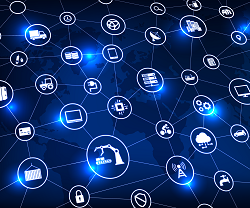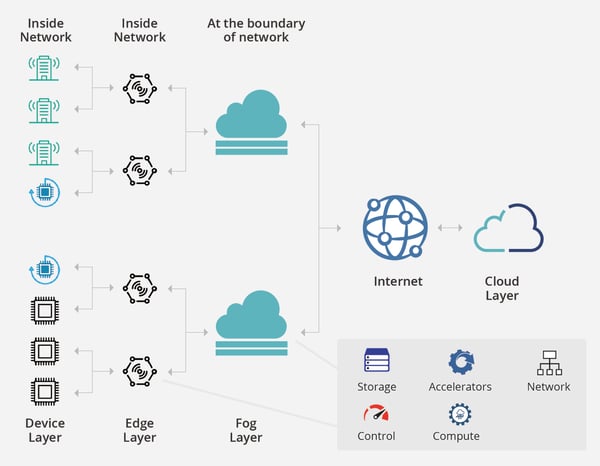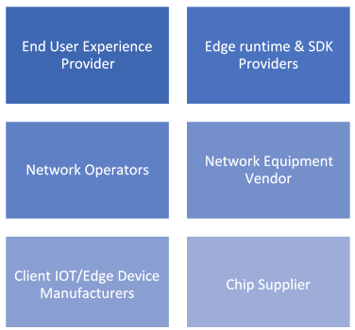 With 5G technology, improved hardware at reduced prices and convenient storage options, the “things” in the IoT continuum are getting smarter each day. In fact, it's predicted that approximately 5.6 billion IoT devices owned by enterprises and government bodies will utilize edge computing for data collection and processing in 2020. Major players in device manufacturing, network operations, cloud computing, and end-user experience are proactively investing largely in this space. Let's take a quick look at what is edge computing, why it is needed, and how it can be leveraged in your organization today.
With 5G technology, improved hardware at reduced prices and convenient storage options, the “things” in the IoT continuum are getting smarter each day. In fact, it's predicted that approximately 5.6 billion IoT devices owned by enterprises and government bodies will utilize edge computing for data collection and processing in 2020. Major players in device manufacturing, network operations, cloud computing, and end-user experience are proactively investing largely in this space. Let's take a quick look at what is edge computing, why it is needed, and how it can be leveraged in your organization today.
What is edge computing and why we need it?
The Cloud-only approach in an IoT solution pushes all the data to the Cloud through a fat pipe. This is a centralized approach that passes on the sensor data through several layers and tiers of processing units before finally reporting the issues in incoming data to the end user, who then typically takes action over it. This happens over a data center that is at least hundreds of kilometers away from sensors with a subsequent delay in response to things. Dumb sensors and smart cloud solutions may work well in some scenarios, but in limited connectivity, this solution becomes troublesome as the sensors send not only the reading (number) data but also images and videos for real-time processing. In these scenarios, the loss of connectivity leads to down time or loss of data in a typical IoT solution.
For changing this type of processing, we must make devices smarter. A device that can ingest, process, and act on the collected data with decision-making, storage, and resilient networking capabilities embedded is called an autonomous thing. It is the shift towards autonomous thingswhich targets to shorten the lengthy process to achieve intelligence by bringing the capability to/near devices.
 Figure 1: Edge Computing
Figure 1: Edge ComputingSuch a solution avoids a fat pipe for transmission, reduces the bandwidth cost which can be very useful in remote areas. Moreover, it requires zero or minimum down time of critical functionalities on intermittent cloud connectivity, thereby reducing the dependency on the Cloud for critical intelligence. Cloud data centers in such solutions tend to be responsible for a subsequent sink of relevant aggregated data, which can be further used for training and learning purposes. This intelligence is again synced continuously with things making them capable of real-time decisions. Due to an ever-decreasing cost of hardware, such devices are not a distant reality but a real commodity today. Providing applications and solutions for such autonomous devices to enhance the capability of the IoT continuum through the Cloud is called edge computing or cloud-assisted Internet of Things or Cloud-of-Things.
Edge computing can help in realizing solutions that were not readily available for general scenarios such as real-time computing, smart devices and more. Computing capability near devices can help increase robustness and quick decision-making in critical conditions.
Here are some benefits of edge computing that can be leveraged by any organization:
For Business
1. On-boarding old and new remote assets for the digital journey.
2. Reusing of the existing machines/devices for deriving intelligence from the raw data.
3. Critical decision-making in real time.
4. Governing and controlling data and assets remotely.
5. Ensuring security and compliance (for on-premise assets automatically).
6. Enabling low footprint on cloud services leading to cost saving.
For Technology
1. Adhering to industry protocols such as CAN bus, Modbus or OPC for connecting assets inside the edge location.

Figure 2: Aspects of edge computing
3. Providing built-in resilience and fault tolerance mechanism for processing.
4. Enabling intelligent data aggregation to efficiently use the bandwidth especially in remote locations such as oil rigs or dams.
5. Utilizing local computation for providing machine learning and analytics capabilities, if available.
6. Enabling large-scale IoT deployment at a global level as well as providing Over The Air (OTA) updates for runtime and computing upgrades.
Conclusion
Embarking on an edge computing journey demands dealing with various aspects ranging from hardware suppliers who design the chipsets to the end-user experience providers who show the relevant information to the end users on dashboards and other mediums. This is again a matrix which changes based on the requirements to be executed in the edge environment.
Organizations must strategize to develop edge computing capabilities using cloud enablers which have their respective edge flavors such as AWS Greengrass, Azure IoT Edge, and IBM Edge Analytics. Moreover, there are emerging open source micro-kernel style runtimes like Apache Edgent, EdgeX Foudry and Liota which should also be targeted to provide different edge computing flavors as per the requirements.
Edge computing requires considerable effort to put on device security, deployment, multiple device integration, data orchestration, maintenance and health monitoring, offline storage and data sync, failure and resilience strategies to be production ready. These considerations help in fulfilling the core business objectives of organizations in achieving true IoT enablement.






